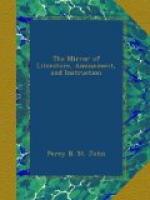“The native habitations were low, of a tent form, and thatched with cocoa-nut leaves; these habitations were not regular, but scattered among the dense vegetation which surrounded them on all sides. The tacca pinnatifida, or Polynesian arrow-root plant, called massoa by the natives, was abundant, as also the fittou, or calophyllum inophyllum, and a species of fan palm, growing to the height of fifteen and twenty feet, called tarapurau by the natives; the areka palm was also seen, and the piper betel was also cultivated among them. They had adopted the oriental custom of chewing the betel; in using this masticatory they were not particular about the maturity of the nuts, some eating them very young as well as when quite ripe; they carried them about enclosed in the husk, which was taken off when used.[3] At a short distance from the beech, inland, was a lake of some extent, nearly surrounded by lofty, densely-wooded hills. Some wild ducks were seen, and a gun being fired at them, the report raised numbers of the ‘plumy tribe,’ filling the air with their screams, alarmed at a noise to which they had been unaccustomed. Several native graves were observed, which were very neat; a stone was placed at the head and the grave neatly covered over by plaited sections of the cocoa-nut frond; no particular enclosures for the burial of the dead were observed. When rambling about, the ’timid female’ fled at our approach. From a casual glimpse of the fair objects, they merit being classed among the ’beautiful portion of the creation;’ their hair was cut close.
“Cooked yams, cocoa-nuts, &c. were brought us by the natives, and their manner was very friendly; of provisions, yams, hogs, &c. could be procured. The natives were anxious to accompany us on the voyage, and it was with the greatest difficulty that we could get rid of them. It seems they have occasional intercourse with islands at some distance from them; two fine polished gourds, containing lime, &c. used with their betel, were observed among them—one was plain and the other ornamented with figures, apparently burnt by some instrument. They stated that these had been procured from the island of Santa Cruz (Charlotte’s Archipelago) by one of the chief’s sons. Some of the natives were observed much darker than others, and there appeared a mixture of some races. Their numerals were as follows:—
“1 Tashi.
2 Rua.
3 Toru.
4 Fa.
5 Hima.
6 Ono.
7 Fithu.
8 Warru.
9 Hiva.
10 Tanga, foru.”




